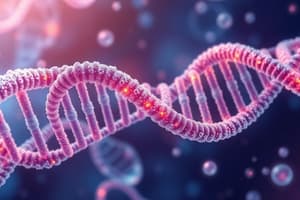Podcast
Questions and Answers
What is the primary reason for recommending increased protein intake in some weight loss diets?
What is the primary reason for recommending increased protein intake in some weight loss diets?
- To increase energy levels and metabolic rate
- To reduce the hunger hormone (ghrelin) and boost appetite suppressing hormones (correct)
- To enhance muscle strength and endurance
- To improve digestion and nutrient absorption
What percentage of the cell's dry weight is comprised of proteins?
What percentage of the cell's dry weight is comprised of proteins?
- 40%
- 55% (correct)
- 30%
- 70%
What are proteins primarily composed of?
What are proteins primarily composed of?
- Carbohydrates
- Amino acids (correct)
- Lipids
- Nucleic acids
What determines the 3-dimensional shape of a protein?
What determines the 3-dimensional shape of a protein?
What is the color of the complex formed in the biuret method for protein quantification?
What is the color of the complex formed in the biuret method for protein quantification?
At what wavelength is the intensity of the color measured in the biuret method?
At what wavelength is the intensity of the color measured in the biuret method?
What are the two ends of a polypeptide chain called?
What are the two ends of a polypeptide chain called?
What is used to measure small volumes accurately in biological research?
What is used to measure small volumes accurately in biological research?
Which method is used to quantify protein by detecting peptide bonds?
Which method is used to quantify protein by detecting peptide bonds?
What is used to determine protein concentrations in unknown samples?
What is used to determine protein concentrations in unknown samples?
What is the range of the P200 micropipette in microliters?
What is the range of the P200 micropipette in microliters?
How is the set volume read on a micropipette?
How is the set volume read on a micropipette?
How is accuracy ensured when using micropipettes?
How is accuracy ensured when using micropipettes?
What is the purpose of creating a standard curve using known protein amounts?
What is the purpose of creating a standard curve using known protein amounts?
What forms the complex in the biuret method for protein quantification?
What forms the complex in the biuret method for protein quantification?
What is displaced by depressing the plunger of a micropipette?
What is displaced by depressing the plunger of a micropipette?
What wavelength is the SpectroVis Plus set to for measurements?
What wavelength is the SpectroVis Plus set to for measurements?
How long is the protein reacted with biuret solution?
How long is the protein reacted with biuret solution?
What is used for calibration in the SpectroVis Plus?
What is used for calibration in the SpectroVis Plus?
Which samples are used to make the standard curve graph?
Which samples are used to make the standard curve graph?
How is the protein content in each unknown sample set estimated?
How is the protein content in each unknown sample set estimated?
What is used to assess the validity of the data in the standard curve graph?
What is used to assess the validity of the data in the standard curve graph?
How is the line equation for the standard curve determined?
How is the line equation for the standard curve determined?
What is used to calculate the amount of protein for each sample set?
What is used to calculate the amount of protein for each sample set?
What is done to the duplicate samples during absorbance data collection?
What is done to the duplicate samples during absorbance data collection?
What is recorded in Table 4.4?
What is recorded in Table 4.4?
How are the absorbance values for protein standards collected?
How are the absorbance values for protein standards collected?
What is used to prepare the SpectroVis Plus for measurements?
What is used to prepare the SpectroVis Plus for measurements?
What is the crucial step in the laboratory procedure involving pipetting?
What is the crucial step in the laboratory procedure involving pipetting?
What is used to create protein standards of different concentrations for the standard curve?
What is used to create protein standards of different concentrations for the standard curve?
What is emphasized to avoid errors in the experiment due to poor pipetting technique?
What is emphasized to avoid errors in the experiment due to poor pipetting technique?
What is used to determine the amount of protein in the samples?
What is used to determine the amount of protein in the samples?
What is crucial to handle carefully to avoid wastage in the setup?
What is crucial to handle carefully to avoid wastage in the setup?
What is used to measure the absorbance at a wavelength of 540 nm?
What is used to measure the absorbance at a wavelength of 540 nm?
What is involved in producing a standard curve for the procedure?
What is involved in producing a standard curve for the procedure?
What is used to dilute protein samples with unknown concentrations?
What is used to dilute protein samples with unknown concentrations?
What is essential to change between different types of samples during pipetting?
What is essential to change between different types of samples during pipetting?
What is used to create protein standards of different concentrations?
What is used to create protein standards of different concentrations?
What is crucial for the accuracy and reliability of the results in the procedure?
What is crucial for the accuracy and reliability of the results in the procedure?
What is used to measure the absorbance at a specific wavelength?
What is used to measure the absorbance at a specific wavelength?
What is the dilution factor for Solution B?
What is the dilution factor for Solution B?
What is the expected protein content in Solution A based on the Isopure™ unflavored protein powder's nutritional information?
What is the expected protein content in Solution A based on the Isopure™ unflavored protein powder's nutritional information?
What is the suitable dilution factor to use for a 12.25% solution of Isopure in a future experiment?
What is the suitable dilution factor to use for a 12.25% solution of Isopure in a future experiment?
What is the validity of measuring undiluted Solution A for protein content?
What is the validity of measuring undiluted Solution A for protein content?
What is the primary concern when using the absorbance from an unknown sample not falling on the linear portion of the standard curve in further calculations?
What is the primary concern when using the absorbance from an unknown sample not falling on the linear portion of the standard curve in further calculations?
What does the text prompt an analysis of regarding the measurements of the glycine solution?
What does the text prompt an analysis of regarding the measurements of the glycine solution?
What is the purpose of creating a standard curve using known protein amounts?
What is the purpose of creating a standard curve using known protein amounts?
What is the interpretation of SD values in the experiment?
What is the interpretation of SD values in the experiment?
What is emphasized to avoid errors in the experiment due to poor pipetting technique?
What is emphasized to avoid errors in the experiment due to poor pipetting technique?
What is crucial for the accuracy and reliability of the results in the procedure?
What is crucial for the accuracy and reliability of the results in the procedure?
What is used to measure the absorbance at a wavelength of 540 nm?
What is used to measure the absorbance at a wavelength of 540 nm?
What determines the volume of a large cube according to the text?
What determines the volume of a large cube according to the text?
Flashcards are hidden until you start studying
Study Notes
Laboratory Procedure Overview
- The pipetting technique is crucial, and it is essential to use the correct tips for different pipettes (P20, P200, and P1000).
- The procedure involves setting up tubes with known protein amounts to produce a standard curve and then measuring dilutions of a protein supplement to determine protein concentration.
- The standard curve is prepared using Bovine serum albumin (BSA) solution and phosphate buffered saline (PBS) to create protein standards of different concentrations.
- The dilution of protein samples with unknown concentrations involves using Isopure™ protein supplement stock solution and other protein solutions.
- The setup includes adding Biuret solution to all prepared tubes and carefully mixing them to ensure the protein and Biuret solutions are well-mixed.
- The absorbance readings from the tubes are used to produce a standard curve and determine the amount of protein in the samples, followed by back calculations for independent measures of protein in the original stock solution.
- The procedure involves graphing and calculations, with questions for consideration throughout the exercise and summary questions at the end.
- Specific volumes of reagents and solutions are required for the setup, and it is essential to label and handle them carefully to avoid wastage.
- The volume of each protein solution is pipetted into respective tubes, and it is crucial to change pipet tips between different types of samples.
- The absorbance at a wavelength of 540 nm is read using a calibrated SpectroVis Plus, and the readings are recorded.
- The procedure emphasizes the importance of practicing with the soft and hard stop of the pipette to avoid errors in the experiment due to poor pipetting technique.
- The setup and procedure involve careful measurement and handling of small volumes, with specific instructions for each step to ensure accuracy and reliability of the results.
Dilution and Protein Concentration Measurement in Laboratory Exercise
- The volume of a large cube can be determined by knowing the volume of a smaller cube and multiplying by the number of small cubes that fit inside the large cube.
- In the laboratory exercise, various solutions of Isopure™ protein powder were measured for protein content.
- Solution A is the undiluted original stock solution of Isopure™ protein powder, while Solutions B, C, and D are diluted.
- Solution B was diluted by a factor of 10, with a total volume of 7 mL (0.7 mL Isopure™ stock + 6.3 mL PBS).
- Solutions C and D were also diluted, with their dilution factors calculated and recorded in Table 4.5.
- The expected amount of protein in Solution A was calculated based on the Isopure™ unflavored protein powder's nutritional information.
- The text prompts an analysis of whether the measured protein concentration in Solution A aligns with the expected amount.
- The validity of measuring undiluted Solution A for protein content is questioned and requires an explanation.
- The text prompts a comparison of the measurements of the glycine solution with the expected protein content.
- Questions related to the experiment are presented, including the interpretation of SD values, comparison of adjusted protein values with expected values, and the limitations of a standard curve.
- The validity of using the absorbance from an unknown sample not falling on the linear portion of the standard curve in further calculations is questioned.
- A challenge question is posed regarding the suitable dilution factor to use for a 12.25% solution of Isopure in a future experiment.
Studying That Suits You
Use AI to generate personalized quizzes and flashcards to suit your learning preferences.





